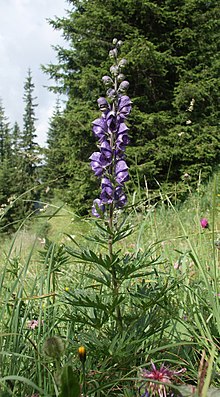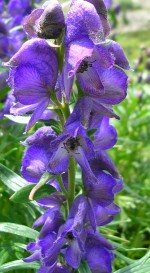
Wolfbane has a long a interesting history. According to legend aconite grew on the hill where Hercules fought Cerberus, the three headed dog that guarded the underworld. The dog’s spittle fell to the ground and became the poison in the plant that was used by several characters in Greek mythology: Hecate, the Greek goddess of magic arts and spells, to kill her father; Medea in an attempt to poison Theseus; and Athena to turn Arachne into a spider. A Germanic tribe believed that aconite turned them into werewolves for battle and during the Middle Ages witches mixed it with belladonna to make a flying ointment. If the stories are not enough to spark interest, the plants themselves will . They grow up to 3 feet tall and bloom in late summer to fall with long spikes of indigo-blue to dark purple flowers that resemble the hoods of medieval monks, leading to the common name of monkshood and helmet flower. This is a beautiful and fascinating plant but must be grown with caution because of is poisonous nature.
 Type: Herbaceous perennial
Type: Herbaceous perennial
Height: 2-4′
Bloom Color: Indigo blue to dark purple
Bloom Time: Late summer to fall
Light: Sun in northern part of range with plenty of water; some shade in southern part of range with plenty of water
Soil: Fertile, consistently moist, well-drained
Hardiness: Zones 3-7 (Does best in cool climates)
Photo Credits Wikipedia